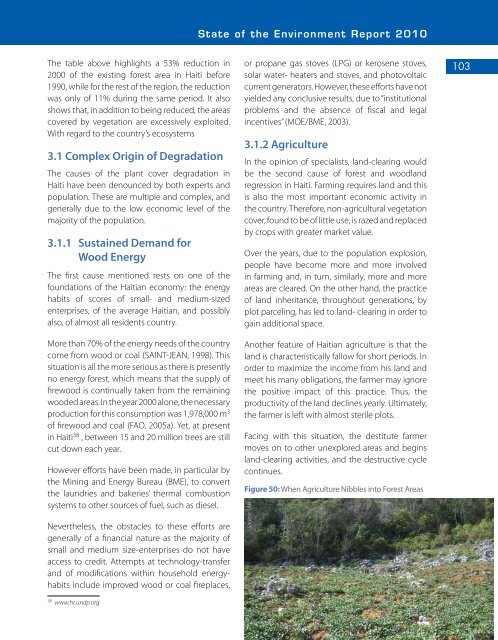GEO Haiti 2010
GEO Haiti 2010
GEO Haiti 2010
Create successful ePaper yourself
Turn your PDF publications into a flip-book with our unique Google optimized e-Paper software.
State of the Environment Report <strong>2010</strong><br />
The table above highlights a 53% reduction in<br />
2000 of the existing forest area in <strong>Haiti</strong> before<br />
1990, while for the rest of the region, the reduction<br />
was only of 11% during the same period. It also<br />
shows that, in addition to being reduced, the areas<br />
covered by vegetation are excessively exploited.<br />
With regard to the country’s ecosystems<br />
3.1 Complex Origin of Degradation<br />
The causes of the plant cover degradation in<br />
<strong>Haiti</strong> have been denounced by both experts and<br />
population. These are multiple and complex, and<br />
generally due to the low economic level of the<br />
majority of the population.<br />
3.1.1 Sustained Demand for<br />
Wood Energy<br />
The first cause mentioned rests on one of the<br />
foundations of the <strong>Haiti</strong>an economy: the energy<br />
habits of scores of small- and medium-sized<br />
enterprises, of the average <strong>Haiti</strong>an, and possibly<br />
also, of almost all residents country.<br />
More than 70% of the energy needs of the country<br />
come from wood or coal (SAINT-JEAN, 1998). This<br />
situation is all the more serious as there is presently<br />
no energy forest, which means that the supply of<br />
firewood is continually taken from the remaining<br />
wooded areas. In the year 2000 alone, the necessary<br />
production for this consumption was 1,978,000 m 3<br />
of firewood and coal (FAO, 2005a). Yet, at present<br />
in <strong>Haiti</strong> 38 , between 15 and 20 million trees are still<br />
cut down each year.<br />
However efforts have been made, in particular by<br />
the Mining and Energy Bureau (BME), to convert<br />
the laundries and bakeries’ thermal combustion<br />
systems to other sources of fuel, such as diesel.<br />
Nevertheless, the obstacles to these efforts are<br />
generally of a financial nature as the majority of<br />
small and medium size-enterprises do not have<br />
access to credit. Attempts at technology-transfer<br />
and of modifications within household energyhabits<br />
include improved wood or coal fireplaces,<br />
38<br />
www.ht.undp.org<br />
or propane gas stoves (LPG) or kerosene stoves,<br />
solar water- heaters and stoves, and photovoltaic<br />
current generators. However, these efforts have not<br />
yielded any conclusive results, due to “institutional<br />
problems and the absence of fiscal and legal<br />
incentives” (MOE/BME, 2003).<br />
3.1.2 Agriculture<br />
In the opinion of specialists, land-clearing would<br />
be the second cause of forest and woodland<br />
regression in <strong>Haiti</strong>. Farming requires land and this<br />
is also the most important economic activity in<br />
the country. Therefore, non-agricultural vegetation<br />
cover, found to be of little use, is razed and replaced<br />
by crops with greater market value.<br />
Over the years, due to the population explosion,<br />
people have become more and more involved<br />
in farming and, in turn, similarly, more and more<br />
areas are cleared. On the other hand, the practice<br />
of land inheritance, throughout generations, by<br />
plot parceling, has led to land- clearing in order to<br />
gain additional space.<br />
Another feature of <strong>Haiti</strong>an agriculture is that the<br />
land is characteristically fallow for short periods. In<br />
order to maximize the income from his land and<br />
meet his many obligations, the farmer may ignore<br />
the positive impact of this practice. Thus, the<br />
productivity of the land declines yearly. Ultimately,<br />
the farmer is left with almost sterile plots.<br />
Facing with this situation, the destitute farmer<br />
moves on to other unexplored areas and begins<br />
land-clearing activities, and the destructive cycle<br />
continues.<br />
Figure 50: When Agriculture Nibbles into Forest Areas<br />
Source: SAH<br />
103

















